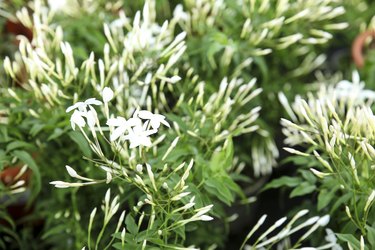
Many gardeners love jasmine plants (Jasminum spp.) for their pleasant sweet fragrance. However, the jasmine species comes in several different varieties, some of which do not produce a fragrance. In general, jasmine plants have green leaves, grow as vines or shrubs and have flowers. Different varieties of jasmine have different growth patterns, and they also have problems with different pests. Among insects, the University of California at Davis considers the most common jasmine pests to include spider mites, mealy bugs and scales.
Types of Jasmine
Video of the Day
Common white jasmine grows as a vine with fragrant white flowers, and it does not usually have many pests. Winter jasmine has unscented yellow flowers and grows as a shrub. It can have problems with spider mites. Other types of jasmine include the scented Confederate or star jasmine, the unscented South African jasmine vine, the deciduous scented Spanish jasmine vine, the unscented and yellow-flowered primrose jasmine shrub and the fragrant Italian jasmine vine. With a few exceptions, jasmine isn't especially susceptible to pests.
Video of the Day
Jasmine and Spider Mites
Spider mites tend to infest winter jasmine from time to time. The mites damage plant foliage by feeding on the sap inside plant leaves. When jasmine has spider mites, its leaves have discolored patches, appear scorched and eventually fall off or die.
To get rid of spider mites on winter jasmine, experts at Clemson University Extension suggest cutting the plant to the ground after it blooms, removing infested trimmings and fertilizing the base of the plant to help it grow back. You could also spray plant leaves with a jet of water to wash away and kill off any mites, or use a miticide (a pesticide specially designed to get rid of mites).
Jasmine and Mealybugs
Mealybugs are tiny, gray wingless insects that sometimes infest jasmine plants. Mealybugs form white masses on plant foliage that look like cotton or waxy growths. Plants with mealybugs often have problems with black sooty mold. Eventually, mealybugs can cause leaves to fall off and twigs to die.
Like mites, mealybugs often fall off of jasmine leaves when the gardener sprays them with a stream of water. UC Davis also suggests using insecticidal soaps or narrow-range oil to get rid of mealybug infestations.
Jasmine and Scales
Jasmine plants sometimes become infested with black scales. These have a rounded appearance and are less than 1/4-inch in length. Black scales are a type of soft scale insect that feeds on plant sap and excretes a honeydew substance that black sooty mold grows on. The honeydew from scales also attracts ants. Jasmine plants that have scales often develop discolored, distorted, dying and dropped leaves. Although a few scales will not severely damage a plant, a large scale infestation can cause severe damage or even death to a plant.
Gardeners can get rid of scales by pruning off severely infected areas of the plant and pruning shrubs to help expose inner branches to warmth and sunlight. For a more natural approach, try introducing ladybugs or parasitic wasps to eat the scales. Horticultural oil also helps get rid of scales.